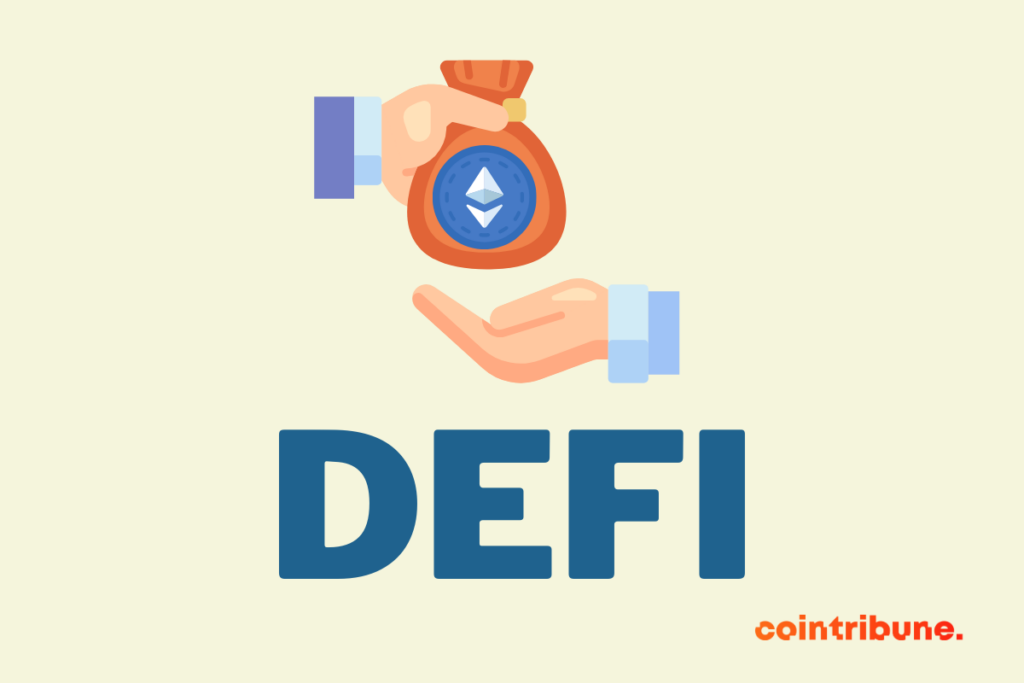DeFi Loans: How Does It Work?
Decentralized finance (DeFi) is redefining the rules of the game in the lending sector, offering an innovative alternative to traditional banking systems. Thanks to blockchain technology, lending in DeFi promises more autonomy, transparency, and efficiency, thus attracting a growing number of users. However, despite its apparent advantages, the loan system in the DeFi ecosystem carries risks and complexities that should not be ignored. This article explores in detail how lending works in DeFi.

Definition and explanation of loans in DeFi
Decentralized finance (DeFi) is revolutionizing the world of credit and financing. Lending in DeFi, unlike traditional credit systems, relies on blockchain technology to offer lending services without intermediaries. In this system, borrowers and lenders interact directly via DeFi platforms like Aave, where smart contracts replace financial institutions. Lending in DeFi allows users to borrow or lend cryptocurrencies, often using other crypto assets as collateral.
The advantages and disadvantages of lending in DeFi
In the world of decentralized finance (DeFi), lending occupies a prominent place, reshaping traditional notions of credit and financing. While promising, these loans have both significant advantages and notable disadvantages.
Accessibility and financial inclusion
One of the most striking advantages of lending in DeFi is its accessibility. Unlike traditional banks, which may be hindered by strict regulations and rigid credit requirements, lending in DeFi is accessible to a broader audience, including in states where banking services are limited. This accessibility promotes financial inclusion, allowing people from diverse backgrounds to access funds that would otherwise be inaccessible to them. Additionally, DeFi platforms operate 24/7, offering unprecedented flexibility in terms of loan service availability.
Transparency and autonomy
Transparency is another key advantage of lending in DeFi. Thanks to the blockchain, every transaction and every interest rate change is recorded transparently and immutably. This feature offers increased clarity and trust for users, who can independently verify transactions and loan conditions. Furthermore, loans in DeFi give users full control over their assets, unlike traditional banking systems where funds may be subject to restrictions or can be frozen.
Interest rates and potential returns
Lending in DeFi can offer more advantageous interest rates for both borrowers and lenders. Platforms like Aave and Compound dynamically adjust interest rates based on supply and demand, which offers higher returns for lenders. For borrowers, this can translate to access to more favorable funds and conditions, essential for financing projects or other financial needs.
Volatility and market risks
However, lending in DeFi is not without risks. The inherent volatility of cryptocurrency prices can significantly affect loans. A sudden drop in prices can lead to the liquidation of collateral, leaving borrowers with significant debts. This price instability presents a major challenge for risk management for both borrowers and lenders.
Security and regulatory risks
Security risks are also a major concern in the DeFi space. Lending platforms can be vulnerable to cyber-attacks, exposing users’ funds to loss risks. Additionally, the regulatory framework of DeFi is still developing, which can lead to legal uncertainty for participants. Users must be aware of these risks and act cautiously when engaging in DeFi lending.

Key players in DeFi lending
Decentralized finance (DeFi) has transformed the lending and credit landscape, introducing new key players who play vital roles in this evolving sector. These players, varied and interdependent, contribute to the unique dynamics of lending in DeFi, each bringing essential elements to the overall system’s functioning.
Borrowers
Borrowers in the DeFi ecosystem are remarkably diverse, ranging from individuals seeking funding for personal projects to startups and companies looking for capital to expand. These borrowers turn to DeFi for several reasons, including easy access to funds, less restrictive procedures compared to traditional credit systems, and the ability to obtain loans without revealing their identity. They use these funds for various purposes, such as starting cryptocurrency projects, funding technological developments, or even for urgent personal needs. The flexibility and accessibility of DeFi loans make these services attractive to a wide range of borrowers.
Lenders
Lenders in the DeFi space are often motivated by the high potential returns offered by the dynamic interest rates of decentralized finance. These lenders can be individuals, cryptocurrency investors, or even traditional financial institutions exploring DeFi opportunities. They provide capital on DeFi platforms and are attracted by the possibility of earning higher interest than offered by bank savings accounts or other traditional investments. Furthermore, some lenders are drawn to the innovative aspect of DeFi, wanting to participate in the forefront of digital finance. Their participation is crucial for providing the necessary liquidity for the functioning of DeFi lending platforms.
DeFi platforms
DeFi platforms, such as Aave and Compound, are at the heart of the DeFi lending system. They provide the necessary infrastructure to connect borrowers and lenders, facilitating transactions and ensuring fund security. These platforms use smart contracts on the blockchain to automate lending processes, including determining interest rates, collecting collateral, and managing repayments. They also offer a range of services, such as liquidity pools where lenders can deposit their assets, and governance mechanisms that allow users to participate in decisions concerning the platform’s evolution. The role of these platforms is essential to ensure transparency, efficiency, and security in DeFi lending.
The lending process in DeFi
Decentralized finance (DeFi) has revolutionized the concept of lending by introducing a process that differs greatly from traditional methods. This process, based on blockchain technology, offers a more transparent and accessible approach to lending.
Collateral deposit and loan application
The DeFi lending process generally starts with the borrower depositing collateral. This collateral, typically in the form of cryptocurrency, is essential to secure the loan. DeFi platforms, like Aave or Compound, use these deposits to create a liquidity pool from which loans can be granted. The borrower must then submit a loan application specifying the desired amount and terms, such as duration and interest rate. These applications are processed by automated algorithms that determine the borrower’s eligibility based on the value of their collateral and other risk factors.
Management of interest rates and terms
Once the loan application is approved, the interest rates and loan terms are established. Interest rates in DeFi are dynamic and vary based on supply and demand on the platform. They are often adjusted in real-time, which can be both an advantage and a challenge for borrowers. The loan terms, including duration and amount, are also defined by smart contracts. These contracts ensure that loan terms are upheld and automate the repayment process, thus reducing the risk of default.
Repayment and liquidation
Borrowers must repay the borrowed amount plus interest within the agreed deadlines. In case of non-compliance with repayment terms, the deposited collateral may be liquidated to cover the loan. This liquidation is generally automated and is triggered when the collateral value falls below a certain threshold, which is a safety measure for lenders. It is therefore imperative for borrowers to closely monitor the value of their collateral and market conditions to avoid such situations.
Conclusion
DeFi loans represent a significant advance in the world of finance, offering a transparent and accessible alternative to traditional credit systems. While this sector presents unique opportunities in terms of accessibility, interest rates, and autonomy, it also comes with risks related to cryptocurrency volatility and security challenges. A thorough understanding of these aspects is crucial to effectively navigate the DeFi ecosystem. DeFi loans continue to evolve, promising to further reshape the financial landscape in the future.
Maximize your Cointribune experience with our "Read to Earn" program! For every article you read, earn points and access exclusive rewards. Sign up now and start earning benefits.
The Cointribune editorial team unites its voices to address topics related to cryptocurrencies, investment, the metaverse, and NFTs, while striving to answer your questions as best as possible.
The views, thoughts, and opinions expressed in this article belong solely to the author, and should not be taken as investment advice. Do your own research before taking any investment decisions.